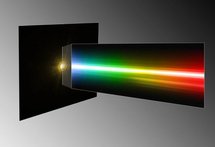
HR 8799 has a mass about one and a half times that of the Sun and hosts a planetary system "that resembles a scaled-up model of our own Solar System," it said.
The target was the middle of three planets -- initially spotted in 2008 -- that are between seven and 10 times the mass of Jupiter.
The finding is important, because a light spectrum is like a fingerprint, ESO said. Hidden within it are telltales of the chemical elements in the planet's atmosphere.
"The result represents a milestone in the search for life elsewhere in the Universe," said ESO.
Until now, astronomers have been able to get only an indirect light sample from an exoplanet, as worlds beyond our Solar System are called.
They do this by measuring the spectrum of a star twice -- while an orbiting exoplanet passes in front of it, and again while the planet is directly behind it.
The planet's spectrum is thus calculated by subtracting one light sample from another.
But the method can only be used if the orientation of the exoplanet's orbit is exactly right, and only a tiny fraction of exoplanetary systems fall into this category.
HR 8799 is thousands of times brighter than the planet, which means that sifting out the spectrum was a technical exploit.
"It's like trying to see what a candle is made of, by observing it from a distance of two kilometers (1.2 miles) when it's next to a blindingly bright 300-watt lamp," said Markus Janson, who led a team who uncovered the spectrum.
They used an infrared detector on ESO's Very Large Telescope, located in Paranal, Chile.
A total of 424 exoplanets have now been spotted since the first, 51 Pegasi b, unofficially called Bellerophon, was detected in 1995, according to the website the Extrasolar Planets Encyclopaedia (http://exoplanet.eu/).
----------------------------------------------------------------------------------------
The target was the middle of three planets -- initially spotted in 2008 -- that are between seven and 10 times the mass of Jupiter.
The finding is important, because a light spectrum is like a fingerprint, ESO said. Hidden within it are telltales of the chemical elements in the planet's atmosphere.
"The result represents a milestone in the search for life elsewhere in the Universe," said ESO.
Until now, astronomers have been able to get only an indirect light sample from an exoplanet, as worlds beyond our Solar System are called.
They do this by measuring the spectrum of a star twice -- while an orbiting exoplanet passes in front of it, and again while the planet is directly behind it.
The planet's spectrum is thus calculated by subtracting one light sample from another.
But the method can only be used if the orientation of the exoplanet's orbit is exactly right, and only a tiny fraction of exoplanetary systems fall into this category.
HR 8799 is thousands of times brighter than the planet, which means that sifting out the spectrum was a technical exploit.
"It's like trying to see what a candle is made of, by observing it from a distance of two kilometers (1.2 miles) when it's next to a blindingly bright 300-watt lamp," said Markus Janson, who led a team who uncovered the spectrum.
They used an infrared detector on ESO's Very Large Telescope, located in Paranal, Chile.
A total of 424 exoplanets have now been spotted since the first, 51 Pegasi b, unofficially called Bellerophon, was detected in 1995, according to the website the Extrasolar Planets Encyclopaedia (http://exoplanet.eu/).
----------------------------------------------------------------------------------------









 Home
Home Politics
Politics









